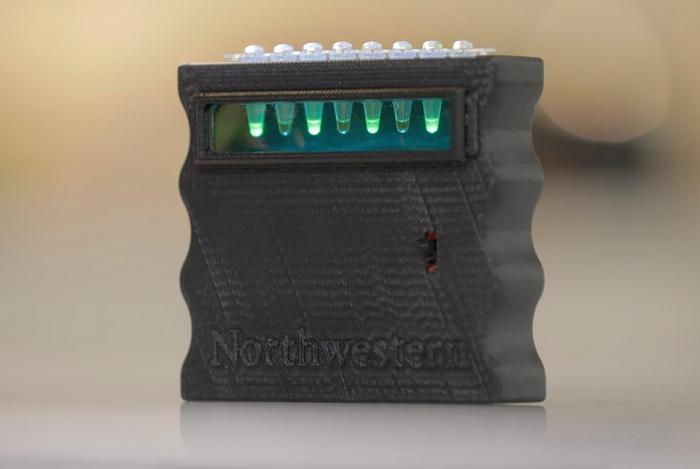
The world of biochemistry is continuously evolving, pushing the boundaries of what is known and understood about sensing technologies. One of the latest breakthroughs comes from researchers at Northwestern University, who have developed an iteration of their sensing platform known as ROSALIND. This newly enhanced version is reported to be ten times more sensitive than its predecessors, providing intriguing possibilities for both environmental and medical applications. The method employed to achieve this remarkable increase in sensitivity revolves around innovative genetic circuitry that amplifies faint signals, akin to how a volume knob can enhance sound for an electric instrument.
Initially developed to detect contaminants in water, ROSALIND’s capabilities are expanding into the intriguing realm of human health diagnostics. The device is engineered to recognize nucleic acids, including vital markers such as DNA and RNA, as well as harmful bacteria such as E. coli. The implications of this dual functionality are profound, as the technology could lead to earlier disease detection and better monitoring of biological systems. The researchers, led by synthetic biologist Julius Lucks, articulate that achieving such sensitivity and versatility was a complex task, yet essential for adapting laboratory-class technologies for practical, real-world applications.
What makes ROSALIND particularly compelling is the way it intercepts and amplifies weak signals. Much like an electric instrument sounds profoundly better when connected to an amplifier, the synthesized system can capture and measure the quiet signals emitted by low-concentration toxins and small molecules. This development is not merely incremental; it opens a wide array of potential uses in both environmental monitoring and clinical diagnostic testing. Lucks emphasizes that while biosensors have the inherent capability to track a variety of human health markers and contaminants, conventional models often lack the sensitivity needed for operation in diverse settings.
Throughout the research process, Northwestern scientists utilized a technique known as cell-free synthetic biology. This involves extracting molecular components such as DNA, RNA, and proteins from cells and reprogramming them to undertake new tasks. With their innovative approach, the scientists have made significant strides in biosensing technologies, allowing ROSALIND to detect and measure substances with remarkable precision. The researchers have managed to create an amplified system that provides increased sensitivity without altering the core properties of the biosensor itself.
In a revealing analogy, Lucks likens the development of the ROSALIND system to that of early transistor radios. In their rudimentary forms, these radios could pick up signals but suffered from various limitations such as weak sound output and inconsistent reception, particularly when the user moved away from the signal source. Just as these radios have evolved through the addition of advanced circuitry to compensate for their limitations, the integration of genetic circuitry in ROSALIND allows for signal amplification. It essentially gives the biosensor a “volume knob,” improving both its sensitivity and reliability in detecting environmental toxins and human health indicators.
The new technological advancements of ROSALIND also include the ability to measure multiple contaminants simultaneously, much like a sophisticated pregnancy test that can gauge different chemical levels at once. The platform’s earlier versions demonstrated a capacity to identify 17 contaminants in water, marking a major step toward environmental safety. The research team takes pride in the fact that their biosensors are not mere laboratory curiosities; instead, they are deployed in ongoing field studies, including projects to monitor lead levels in drinking water within the Chicago region.
As the team continues to innovate, they envision ROSALIND being adapted for even broader applications. The sensor technology is being developed for functionalities that involve detecting human health markers, evaluating food quality, and monitoring agricultural compounds. The potential for such multipurpose usage could revolutionize various sectors, from healthcare to environmental safety, improving public health outcomes and enhancing food safety protocols.
Financial backing for this significant research comes from several esteemed organizations, including he National Institutes of Health and the Defense Advanced Research Projects Agency (DARPA). Such support demonstrates the promise that the scientific community sees in the ROSALIND platform and acknowledges its potential impact on society. With foundational underpinnings in synthetic biology and virology, this technology stands at the intersection of biosensors and public health.
In addition, there are commercial enterprises taking an interest in the technology; for instance, a startup named Stemloop is working on bringing ROSALIND to market. This reinforces the potential scaling of such innovations and demonstrates the growing intersection of academia and industry. Lucks and his team acknowledge their affiliations with Stemloop, highlighting a commitment to translating scientific discoveries into practical solutions that can serve society.
Visibility through publications is a crucial component of scientific advancement. The results of their research have been made available in the prestigious journal Nature Chemical Biology, further solidifying the credibility of their findings. The integration of academic rigor and practical application serves as a powerful reminder of the role that fundamental research plays in driving societal change and progress.
ROSALIND, particularly its newest iteration, represents a thrilling convergence of multiple scientific disciplines—from synthetic biology to chemistry and environmental science. As researchers look toward the future and continue refining the capabilities of this sensing platform, the potential applications seem almost boundless. New iterations of ROSALIND promise not only to enhance the accuracy and sensitivity of contaminants detection but also to pave the way for future innovations across a spectrum of scientific fields. The implications could resonate throughout healthcare, environmental monitoring, food safety, and beyond.
In summary, the evolution of ROSALIND underscores the importance of innovation in the field of biotechnology. Each technical achievement brings researchers closer to reliable, sensitive, and comprehensive detection methods that can address pressing global challenges. As this groundbreaking research continues to advance, it propels both the scientific community and society into a new era of biotechnological possibilities.
Subject of Research: Sensitivity improvements in biosensing technology
Article Title: Northwester University’s ROSALIND Platform Enhances Detection Sensitivity Tenfold
News Publication Date: January 13, 2024
Web References: Nature Chemical Biology
References: None available
Image Credits: Credit: Northwestern University
Keywords: Synthetic Biology, Environmental Monitoring, Biosensors, Disease Detection, Nucleic Acids, Toxins.





